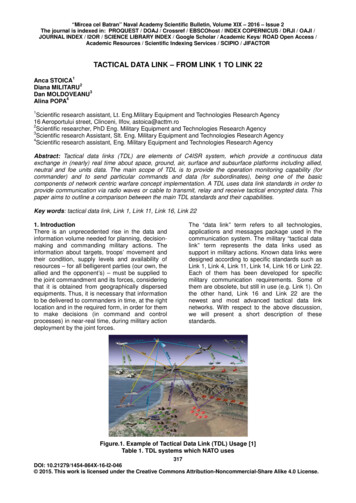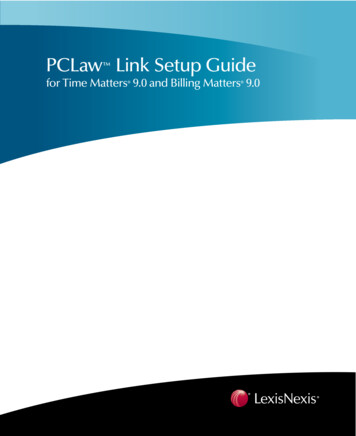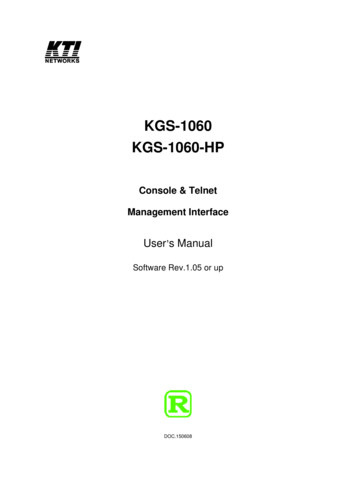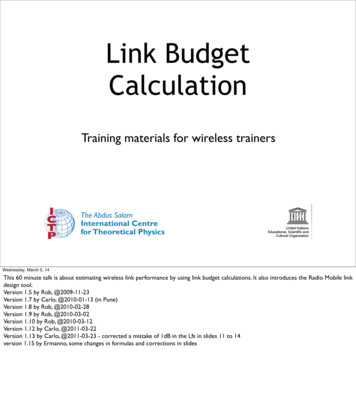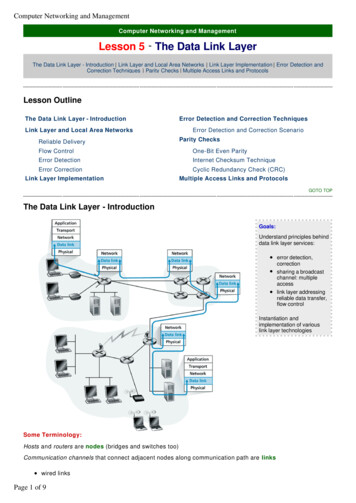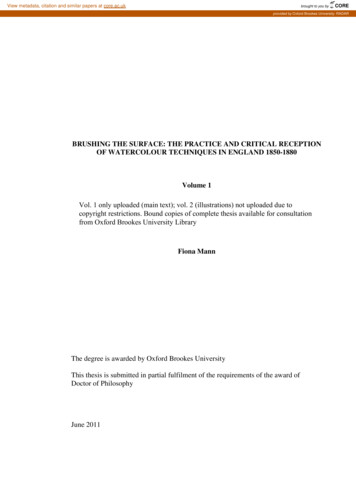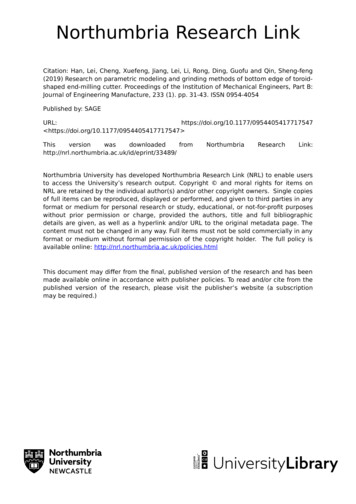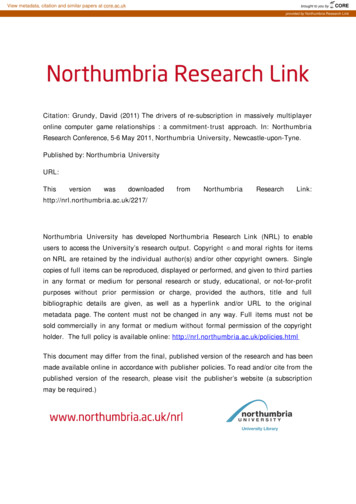
Transcription
View metadata, citation and similar papers at core.ac.ukbrought to you byCOREprovided by Northumbria Research LinkCitation: Grundy, David (2011) The drivers of re-subscription in massively multiplayeronline computer game relationships : a commitment- trust approach. In: NorthumbriaResearch Conference, 5-6 May 2011, Northumbria University, Newcastle-upon-Tyne.Published by: Northumbria Northumbria University has developed Northumbria Research Link (NRL) to enableusers to access the University’s research output. Copyright and moral rights for itemson NRL are retained by the individual author(s) and/or other copyright owners. Singlecopies of full items can be reproduced, displayed or performed, and given to third partiesin any format or medium for personal research or study, educational, or not-for-profitpurposes without prior permission or charge, provided the authors, title and fullbibliographic details are given, as well as a hyperlink and/or URL to the originalmetadata page. The content must not be changed in any way. Full items must not besold commercially in any format or medium without formal permission of the copyrightholder. The full policy is available online: http://nrl.northumbria.ac.uk/policies.htmlThis document may differ from the final, published version of the research and has beenmade available online in accordance with publisher policies. To read and/or cite from thepublished version of the research, please visit the publisher’s website (a subscriptionmay be required.)
AN EMPIRICAL INVESTIGATION INTO THE DRIVERS OFRE-SUBSCRIPTION IN MASSIVELY MULTIPLAYER ONLINE GAMES:A COMMITMENT TRUST THEORY APPROACHDr David Grundy
Research: Overview Relationship Marketing PhD which is examining, using Commitment-TrustTheory (Morgan & Hunt, 1994), the customer decision to maintainsubscribing to a massively multiplayer online game in a businessenvironment contaminated with grey market activity.This PhD is not an examination of initial purchase decision, but of ongoing,post-purchase, customer retention.Three major objectives Firstly, which of the relationship marketing customer service constructsidentified from the literature are important in the re-subscription decisionmade by customers?Secondly, are there relevant factors in the context which affect thesecustomer service constructs?And finally, how do the key constructs interact to influence the resubscription decision?
Computer Games as a Creative Industry: Overview Worldwide the computer games industry is worth around 30bn a year. In the UK the computer games industry is around 3bn a year in size(Economist, 2009) The UK is has the 4th largest games industry in the World (Economist,2009). The North-East of the UK has five major games studios alone, with around280 firms based in the UK. (HM UKT&I, 2009) Around 1,000 people work in computer games in North East of England.With around 10,000 people working in the computer gaming sector in theUK (Skills Council for Creative Media, 2009)
Computer Games as a Creative Industry: MMO’s Massively Multiplayer Online (MMO’s) computer games estimated at a 9bnworldwide segment of the market. Persistent online worlds, open ended, benefits regarding copying andpiracy, based on controlled servers. Many different business models including; subscription based, free to play,micro-transactions, one-off fees. The largest subscription based game is Blizzard Entertainment’s World ofWarcraft with 12m subscribers paying an average of 10 a month, with 62%of the subscription market (in perspective, the next biggest is Runescape at7%)
Monthly Entertainment Share of Wallet (%)CategoryParticipating in Activities such asdining out, shopping, going to amuseumRegular TV packages (such as basiccable)Participating in non-media activitiesat home, such as hobbiesAttending live events (such asconcerts or sporting events)Seeing movies at a theatreCellular phone-related entertainment(all but calling plan)Video game content (new and usedgames, downloadable content,rentals and peripherals)All USHomesVideo .4%5.9%5.3%5.3%4.9%9.3%2009 Average US Monthly Entertainment Expenditures (Nielson, 2010a)
Morgan and Hunt (1994a) Original Framework
The Nature of the Relational Channel: OverviewThe relational channels in mass market business to customerrelationships which have communities or consumptive tribes
A Model of Commitment and Trust in the MMO game setting
Methods: Overview Literature Review (Construct Validity, Content Validity) Two prior studies into area ( Published as Grundy, 2008a; Grundy 2008b) examininggold selling and methodological issues. (Construct Validity, Content Validity) Based on wide Literature Review and conclusions of Grundy (2008a), web-basedSurvey chosen. Surveys extensively used in Commitment-trust theory research. WebBased survey used in Li, Browne & Wetherbe (2006) (Instrument Validation) Pilot Survey (April/May 2009) (Construct Validity, Content Validity) Web-based Survey; Methodological sampling issues (Representativeness) Engaged with MMO “Community Leaders” in promoting survey. Survey also madeuse of social networking sites. (Representativeness) Main Data Collection Period beginning first three weeks of June 2009 (1st till 19th) 2,226 started survey; 1,528 completed survey. Statistical Analysis tests of InternalReliability (Cronbach's α, correlations) and Structural Equation Modelling (usingAMOS in SPSS)
Comparison of this study’s data collected with other large scale research projects
Survey Descriptive StatisticsGender Divide90% Male, 10% FemaleAverage Age28.35 years oldRespondent Location30% USA, 20% UK, 4% Canada, 3% Sweden, manycountries represented at less than 3%Employment52% in Full time employment, 22% StudentsCurrent marital status57% Single/Divorced/Widower, 39%Married/Engaged/Living with a PartnerAverage hours spentplaying per week23.77 hours a weekMethod of Payment50% pay monthly, 7% Bi-Monthly, 18% three monthly,and 13% every 6 monthsRenewal75% of respondents subscriptions automatically renewed
Seventeen Path Modelling with Standardised Regression Estimates
Goodness of Fit TestThresholds and InterpretationRelative Chi Squared. different researchers haverecommended using ratios as lowas 2 or as high as 5 to indicate areasonable fit. (Marsh and Hocevar,1985, p.567)Comparative Fit Index(CFI)Normed fit index (NFI)In our experience, models withoverall fit indices of less than .9 canusually be improved substantially.These indices, and the generalhierarchical comparisons describedpreviously, are best understood byexamples. (Bentler and Bonett,1980, p.600)Relative Chi Squared 4.636CFI 0.899NFI 0.875IFI 0.900Incremental Fit Index (IFI)Root mean square errorof approximation(RMSEA)Seventeen PathModelPractical experience has made usfeel that a value of the RMSEA ofabout .05 or less would indicate aclose fit of the model in relation tothe degrees of freedom. (Browneand Cudeck, 1993, p.239)RMSEA 0.04Goodness-of-Fit Statistics for Seventeen Path Model
Five Path Modelling with Standardised Regression Estimates
Goodness of FitTestRelative ChiSquaredComparative FitIndex (CFI)Normed fit index(NFI)Incremental FitIndex (IFI)Root mean squareerror ofapproximation(RMSEA)Thresholds and InterpretationSeventeen PathRelationshipmodelFive PathRelationshipmodel. different researchers haverecommended using ratios aslow as 2 or as high as 5 toindicate a reasonable fit. (Marshand Hocevar, 1985, p.567)Relative ChiSquared 4.636Relative ChiSquared 4.878CFI 0.899CFI 0.918NFI 0.875NFI 0.909IFI 0.900IFI 0.918RMSEA 0.04RMSEA 0.06In our experience, models withoverall fit indices of less than .9can usually be improvedsubstantially. These indices, andthe general hierarchicalcomparisons describedpreviously, are best understoodby examples. (Bentler andBonett, 1980, p.600)Practical experience has made usfeel that a value of the RMSEA ofabout .05 or less would indicatea close fit of the model in relationto the degrees of freedom.(Browne and Cudeck, 1993,p.239)Goodness of Fit Statistics for Five Path Model
Index (CFI) In our experience, models with overall fit indices of less than .9 can usually be improved substantially. These indices, and the general hierarchical comparisons described previously, are best understood CFI 0.899 CFI 0.918 Normed fit index (NFI) NFI 0.875 NFI 0.909 Incremental Fit by examples. (Bentler and Bonett, 1980, p.600)


